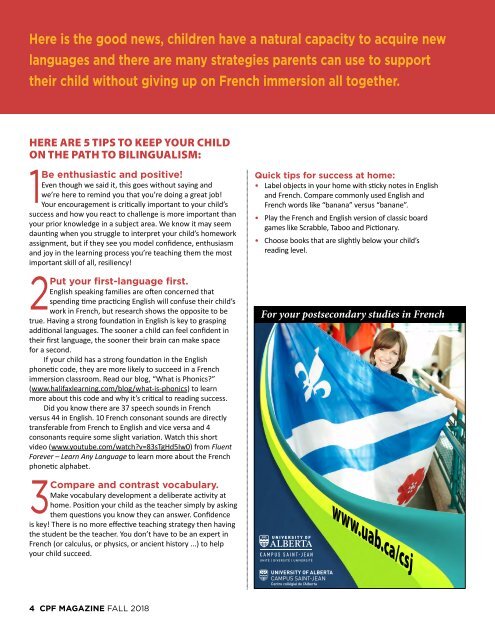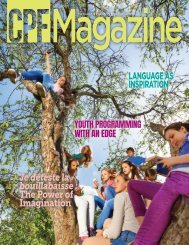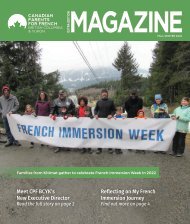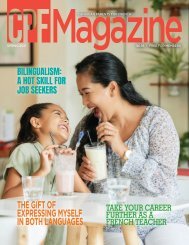CPFMagazine_Fall-2018_Issue
A national network of volunteers, parents and stakeholders who value French as an integral part of Canada. CPF Magazine is dedicated to the promotion and creation of French-second-language learning opportunities for young Canadians.
A national network of volunteers, parents and stakeholders who value French as an integral part of Canada. CPF Magazine is dedicated to the promotion and creation of French-second-language learning opportunities for young Canadians.
Create successful ePaper yourself
Turn your PDF publications into a flip-book with our unique Google optimized e-Paper software.
Here is the good news, children have a natural capacity to acquire new<br />
languages and there are many strategies parents can use to support<br />
their child without giving up on French immersion all together.<br />
HERE ARE 5 TIPS TO KEEP YOUR CHILD<br />
ON THE PATH TO BILINGUALISM:<br />
1Be enthusiastic and positive!<br />
Even though we said it, this goes without saying and<br />
we’re here to remind you that you’re doing a great job!<br />
Your encouragement is critically important to your child’s<br />
success and how you react to challenge is more important than<br />
your prior knowledge in a subject area. We know it may seem<br />
daunting when you struggle to interpret your child’s homework<br />
assignment, but if they see you model confidence, enthusiasm<br />
and joy in the learning process you’re teaching them the most<br />
important skill of all, resiliency!<br />
2<br />
Put<br />
your first-language first.<br />
English speaking families are often concerned that<br />
spending time practicing English will confuse their child’s<br />
work in French, but research shows the opposite to be<br />
true. Having a strong foundation in English is key to grasping<br />
additional languages. The sooner a child can feel confident in<br />
their first language, the sooner their brain can make space<br />
for a second.<br />
If your child has a strong foundation in the English<br />
phonetic code, they are more likely to succeed in a French<br />
immersion classroom. Read our blog, “What is Phonics?”<br />
(www.halifaxlearning.com/blog/what-is-phonics) to learn<br />
more about this code and why it’s critical to reading success.<br />
Did you know there are 37 speech sounds in French<br />
versus 44 in English. 10 French consonant sounds are directly<br />
transferable from French to English and vice versa and 4<br />
consonants require some slight variation. Watch this short<br />
video (www.youtube.com/watch?v=83sTgHd5Iw0) from Fluent<br />
Forever – Learn Any Language to learn more about the French<br />
phonetic alphabet.<br />
3<br />
Compare<br />
and contrast vocabulary.<br />
Make vocabulary development a deliberate activity at<br />
home. Position your child as the teacher simply by asking<br />
them questions you know they can answer. Confidence<br />
is key! There is no more effective teaching strategy then having<br />
the student be the teacher. You don’t have to be an expert in<br />
French (or calculus, or physics, or ancient history ...) to help<br />
your child succeed.<br />
Quick tips for success at home:<br />
• Label objects in your home with sticky notes in English<br />
and French. Compare commonly used English and<br />
French words like “banana” versus “banane”.<br />
• Play the French and English version of classic board<br />
games like Scrabble, Taboo and Pictionary.<br />
• Choose books that are slightly below your child’s<br />
reading level.<br />
For your postsecondary studies in French<br />
www.uab.ca/csj<br />
4 CPF MAGAZINE FALL <strong>2018</strong>

















